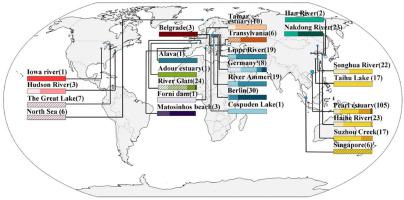Environmental Pollution ( IF 7.6 ) Pub Date : 2023-05-26 , DOI: 10.1016/j.envpol.2023.121893 Tao Wang 1 , Hongyan Zou 1 , Danyang Li 1 , Jian Gao 1 , Qingwei Bu 2 , Zhanyun Wang 3

|
Synthetic musks, as an alternative product of natural musks, are widely used in almost all fragrances of consumer products, such as perfumes, cosmetics and detergents. During the past few decades, the production of synthetic musks has been increasing year by year, subsequently followed by large concern about their adverse effects on ecosystems and human beings. Until now, several studies have reviewed the latest development of analytical methods of synthetic musks in biological samples and cosmetics products, while there is still lack of a systematic analysis of their global distribution in different environmental media. Thus, this review summarizes the occurrence of synthetic musks in the environment including biota around the world and explores their global distribution patterns. The results show that galaxolide (HHCB), tonalide (AHTN), musk xylene (MX) and musk ketone (MK) are generally the most frequently detected synthetic musks in different samples with HHCB and AHTN being predominant. Higher concentrations of HHCB and AHTN are normally found in western countries compared to Asian countries, indicating more consumptions of these musks in western countries. The persistence, bioaccumulation and toxicity (PBT) of synthetic musks (mainly for polycyclic musks and nitro musks) are also discussed. The risk quotients (RQs) of HHCB, AHTN, MX and MK in most waters and sediments are below 0.1, reflecting a low risk to aqueous and sediment-dwelling species. In some sites, e.g., close to STPs, high risks (RQs>1) are characterized. Currently, limited data are available for macrocyclic musks and alicyclic musks in terms of either occurrence or PBT properties. More studies with an expanded scope of chemical type, geographical distribution and (synergic) toxicological effects especially from a long-term point of view are needed.
中文翻译:

合成麝香在环境中的全球分布及生态风险评估
合成麝香作为天然麝香的替代产品,广泛应用于香水、化妆品、洗涤剂等几乎所有消费品的香精中。在过去的几十年中,合成麝香的产量逐年增加,随之而来的是人们对其对生态系统和人类的不利影响的广泛关注。到目前为止,已有多项研究综述了生物样品和化妆品中合成麝香分析方法的最新进展,但仍缺乏对其在不同环境介质中全球分布的系统分析。因此,本综述总结了合成麝香在包括世界各地生物群在内的环境中的出现情况,并探讨了它们的全球分布模式。结果表明,佳乐麝香(HHCB)、托那利特(AHTN)、二甲苯麝香 (MX) 和麝香酮 (MK) 通常是不同样品中最常检测到的合成麝香,其中 HHCB 和 AHTN 占主导地位。与亚洲国家相比,西方国家通常发现 HHCB 和 AHTN 的浓度更高,这表明西方国家对这些麝香的消费更多。还讨论了合成麝香(主要为多环麝香和硝基麝香)的持久性、生物蓄积性和毒性(PBT)。大多数水域和沉积物中 HHCB、AHTN、MX 和 MK 的风险商数 (RQ) 低于 0.1,反映出对水生和沉积物栖息物种的风险较低。在某些站点,例如靠近 STP 的站点,具有高风险 (RQs>1) 的特征。目前,就发生率或 PBT 特性而言,大环麝香和脂环麝香的可用数据有限。











































 京公网安备 11010802027423号
京公网安备 11010802027423号